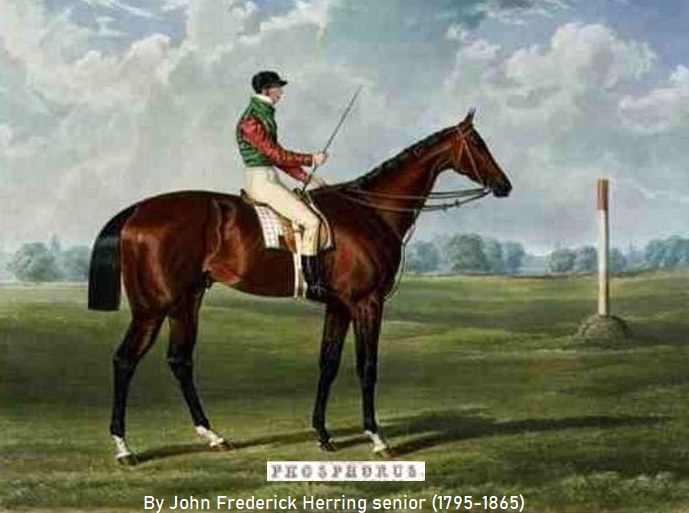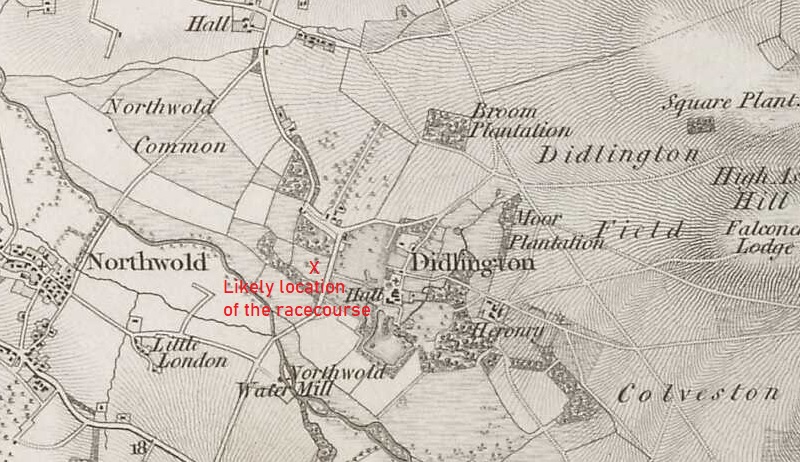Didlington Hall, built of white and red bricks, based on a design from the Georgian period, was situated between Brandon and Swaffham and to the south-east of Downham Market. The estate was originally owned by the Wilson family, where Robert Wilson, 9th Baron Berners resided until his death in 1838. Colonel Robert Wilson was a huge fan of racing, and his racing colours of light blue with black trim, and black cap, were often seen in the best of winners enclosures. The Wilson family sold the estate to Lord William Powlett in 1846, but he was only resident for a short time before it was sold on to William George Tyssen Amherst in the early 1850s. Lord Berners was called to the House of Lords in 1832, but by then he already owned Didlington Hall, stud and estate where he bred some very prominent racehorses. One of his best stallions was Lamplighter who won at the First Spring meeting at Newmarket in 1829, and followed up by winning the prestigious Kings 100 Guineas race at Ipswich. At stud Lamplighter was a huge success for Lord Berners, giving him Mayday and Phosphorus.
Lord Berners name occupied a conspicuous place in the 1834 Racing Calendar, as he owned Mayday, who won the 1000 Guineas, but who tragically broke her leg when the 1834 Oaks was at her mercy. Mayday, a bay filly by Lamplighter out of a Rubens mare, was bred by Lord Berners at his Didlington Stud. Three years later Prosphorus, a bay colt by Lamplighter out of a Rubens mare, was foaled at the same stud and was well fancied by Lord Berners to win the 1837 Epsom Derby. Leading up to the race he backed the colt at some fancy prices, but prior to the start of the race it was widely believed that Phosphorus was lame, but this did not deter Lord Berners and his friends from backing it at 10/1, 15/1 and 20/1 as it drifted when word spread amongst the bookmakers of the colt's lameness. On the day, 40/1 was offered and taken, despite the doubt right up to the time of the off. In the event Phosphorus and Caravan fought a magnificent duel, neither gaining the upper-hand until, right on the line, George Edwards manually forced Phosphorus's nose in front. The good Lord celebrated in style back at Didlington Hall, but within a year he had died on 28th March 1838, aged 78, although he had enjoyed a racing career lasting more than 40 years.
1834 1000 Guineas MAYDAY (SR 1862) 6/1 owned by 9th Baron Berners, trained by John Doe at Newmarket and ridden by John Barham Day
1837 Epsom Derby PHOSPHORUS (SR 1985) 40/1 owned by 9th Baron Berners, trained by John Doe at Newmarket and ridden by George Edwards

In 1910 the Didlington Estate, which at the time extended over 7000 acres, was put up for sale. It had been the home of the Right Honourable Lord Amherst of Hackney, who frequently entertained the King and other members of the Royal Family at his stately home. Within the grounds of the estate was an old racecourse, not only used for private race meetings, but also used as a training ground by both Mayday, 1000 Guineas winner, and Phosphorus, 1837 Epsom Derby winner. The saddle room at Didlington Hall was adorned with racing plates from past champions owned and bred by Lord Berners, with pride of place going to the racing shoes of Phosphorus. The racecourse was surrounded by many ancient trees, including avenues of limes planted as early as 1689. As well as the racecourse, the grounds contained a lake spread over 60 acres, a private cricket ground, bowling green an d tennis lawn, the entire estate advertised itself as one of the finest sporting estates in the Eastern Counties. As well as being used by Classic winners Mayday and Phosphorus, other top-class racehorses like Lamplighter and Camarine were trialled on the course.
I am grateful to Ordnance Survey (© Crown Copyright) for permission to use the 1824 map shown below.
The racecourse/training ground was located on the approach to the Hall and was known as the Long Gallop.

During the ownership of the Amherst family the stables were still used, although they never again reached the dizzy heights of Classic winners which Lord Berners had achieved. The approach to the Lodge was where the training ground was located, and it was known as 'the long gallop'. In those early years of the 20th century Didlington Hall had expanded to 80 bedrooms, but in the end, it became too big for its own survival, requiring such a huge staff to care for it. It was demolished in the early 1950s, although the watching tower and stables seem to have been spared. It is not certain whether the famous racing plates can still be seen in the stable court, which is now occupied.
Much of the information about this course has been found using internet research and is in the public domain. However, useful research sources have been:-
London Illustrated News
Racing Illustrated 1895-1899
The Sporting & Dramatic Illustrated
Northern Turf History Volumes 1-4 by J.Fairfax-Blakeborough
The Sporting Magazine
A Long Time Gone by Chris Pitt first published in 1996 ISBN 0 900599 89 8
Racing Calendars which were first published in 1727



